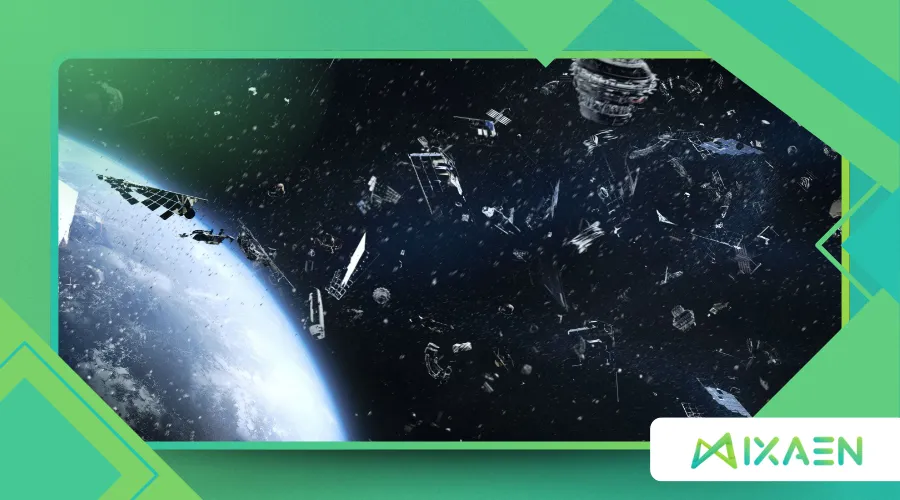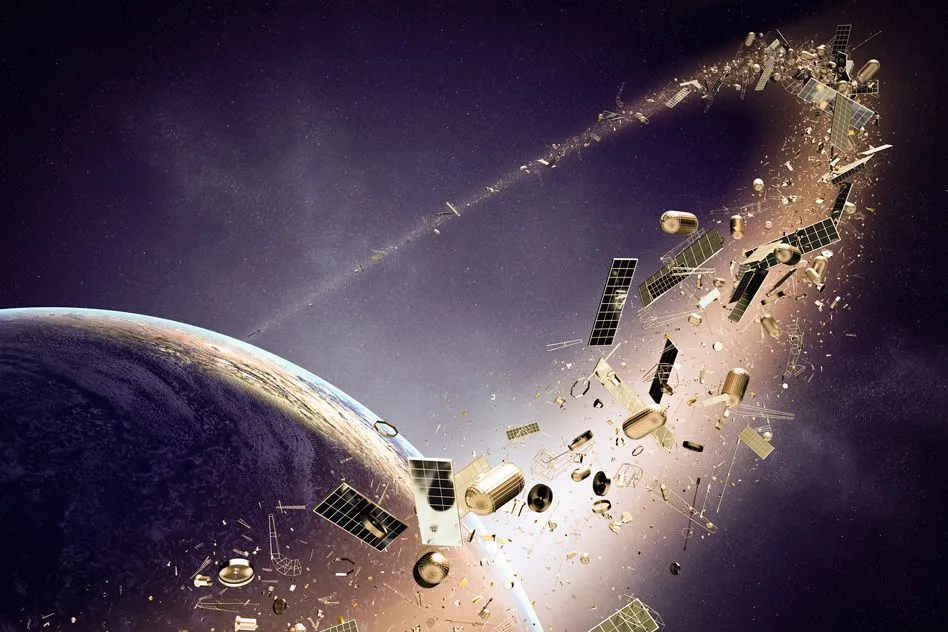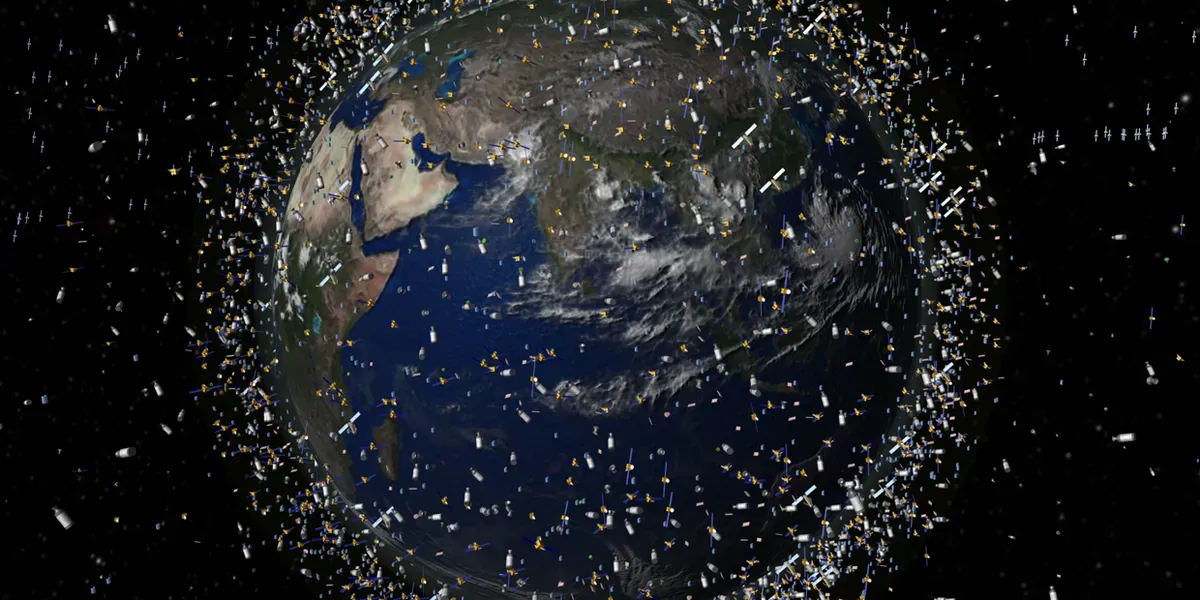Space Debris in Orbit: Dangers for Satellites and Astronauts

Space debris in orbit swirls like a cosmic storm, threatening satellites and astronauts with catastrophic collisions.
Anúncios
This growing menace, born from humanity’s spacefaring ambitions, demands urgent attention.
Discarded rocket stages, defunct satellites, and tiny fragments—some as small as a paint fleck—now clutter Earth’s orbital highways.
With over 27,000 tracked objects and countless untraceable bits, the risks are escalating.
Why should we care?
Because this orbital chaos jeopardizes our communication networks, scientific missions, and human lives in space.
The implications extend beyond immediate dangers; they threaten the future of space exploration itself.
As we continue to launch more satellites and conduct missions, the risk of collision increases exponentially.
We must recognize that space is not an infinite resource, and our actions have consequences that could last for generations.
The Invisible Threat Above
Imagine a highway where cars, broken parts, and loose bolts speed at 17,500 miles per hour.
That’s low Earth orbit (LEO), where space debris in orbit creates a perilous environment.
A single collision can trigger a chain reaction, known as the Kessler Syndrome, where one impact spawns thousands of new fragments, each a potential missile.
In 2009, the collision between a defunct Russian Cosmos satellite and an active Iridium satellite generated over 2,000 trackable fragments, amplifying risks for operational spacecraft.
Satellites powering GPS, weather forecasts, and internet connectivity face constant jeopardy.
Even a centimeter-sized fragment can puncture a satellite’s solar panels or cripple its electronics, rendering it useless.
The statistics are alarming; the European Space Agency estimates that there are over 100 million pieces of debris smaller than 1 cm, many of which are untracked.
These fragments can cause significant damage at high speeds, making the risk even more pronounced for both satellites and astronauts.
Astronauts aboard the International Space Station (ISS) are not immune.
The ISS has executed over 30 debris-avoidance maneuvers since 1999, dodging objects that could pierce its hull.
In 2021, a tiny piece of debris punched a 5mm hole in the ISS’s robotic arm.
Had it struck a critical module, the consequences could have been dire.
The stakes are clear: space debris in orbit isn’t just a technical nuisance—it’s a ticking time bomb for space exploration.
A Growing Problem with Deep Roots
The origins of orbital clutter trace back to the Space Race.
Early missions prioritized reaching orbit over cleaning up afterward.
Rocket boosters, payload shrouds, and even tools dropped during spacewalks have accumulated over decades.
Today, the problem accelerates with the rise of mega-constellations like Starlink, which plans to deploy tens of thousands of satellites.
While these networks promise global connectivity, they also flood LEO with new risks.
A 2023 study by the European Space Agency (ESA) estimates that over 100 million debris fragments smaller than 1 cm now orbit Earth, most untrackable yet still lethal at high velocities.
This rapid increase in satellite launches without corresponding cleanup measures exacerbates the existing problem.
Consider this analogy: space debris in orbit is like litter in a pristine forest.
At first, a few wrappers seem harmless, but over time, the trash pile grows, choking wildlife and scarring the landscape.
Similarly, each new launch adds to the orbital landfill, threatening the sustainability of space activities.
The question isn’t whether a major incident will occur—it’s when.
As we continue to prioritize technological advancement, we must also prioritize responsible stewardship of the orbital environment.

The Ripple Effects on Technology and Society
Satellites are the backbone of modern life, enabling everything from disaster response to financial transactions.
A single collision could disrupt these systems, with cascading effects.
For example, imagine a scenario where a telecom satellite servicing rural hospitals is destroyed by a rogue fragment.
Telemedicine services collapse, delaying critical care for thousands.
This isn’t science fiction—it’s a plausible outcome if we fail to act.
The economic toll could be staggering, with satellite replacement and cleanup costs running into billions.
Moreover, the broader implications of such disruptions can lead to loss of public trust in technology, affecting everything from stock markets to emergency services.
Astronaut safety is equally critical.
In a hypothetical mission, an astronaut conducting a spacewalk to repair a telescope is struck by a micrometeoroid-sized debris piece.
The suit’s breach triggers a life-or-death scramble to return to the spacecraft.
Such scenarios underscore the human cost of inaction.
Space debris in orbit doesn’t discriminate—it endangers crewed missions and robotic ones alike.
The reality is that as we push the boundaries of exploration, we must also ensure the safety and sustainability of our endeavors.
+ Gemini Project: The Space Program That Prepared Humanity for the Moon
| Impact of Space Debris on Satellites | Consequences |
|---|---|
| Collision with large debris (>10 cm) | Total satellite loss, mission failure |
| Impact with small debris (1-10 cm) | Partial damage, reduced functionality |
| Micrometeoroid strikes (<1 cm) | Surface erosion, component degradation |
Technological and Policy Solutions
Tackling this crisis requires innovation and cooperation.
Active debris removal (ADR) technologies, like robotic arms or nets, are emerging to capture defunct satellites.
For instance, the ClearSpace-1 mission, set for 2026, aims to remove a 100-kg rocket stage from orbit, proving the concept.
Meanwhile, “self-destructing” satellites designed to burn up in the atmosphere after their lifespan offer a preventive approach.
These solutions, however, face hurdles—high costs, technical complexity, and the need for global coordination.
The challenge lies not just in developing these technologies but also in ensuring they are implemented effectively.
Policy lags behind technology.
The 1967 Outer Space Treaty assigns liability for space objects but lacks enforceable debris mitigation rules.
Nations like the U.S. and China have tested anti-satellite weapons, creating debris clouds that persist for years.
In 2021, Russia’s ASAT test destroyed a satellite, adding 1,500 trackable fragments to LEO.
Such actions highlight the need for binding international agreements.
Shouldn’t we demand accountability for those who litter our orbital commons?
For more insights on space debris and international policy, check out NASA.
| Proposed Debris Mitigation Strategies | Challenges |
|---|---|
| Active Debris Removal (ADR) | High costs, technical risks |
| End-of-Life Satellite Deorbiting | Limited adoption, enforcement issues |
| Improved Tracking Systems | Inability to track sub-cm debris |

The Role of Public Awareness
Public ignorance fuels inaction.
Many assume space is a boundless frontier, immune to human impact.
Yet, the reality is stark: space debris in orbit threatens the very technologies we take for granted.
Educational campaigns can shift perceptions, much like recycling drives transformed waste management on Earth.
By highlighting real-world consequences—like disrupted GPS during a hurricane—advocates can rally support for cleaner orbits.
Increased awareness can lead to greater public pressure on policymakers to take action.
Private companies also have a stake.
SpaceX, for example, has committed to deorbiting its Starlink satellites within five years of mission end.
But voluntary measures aren’t enough.
Governments must incentivize compliance, perhaps through tax breaks for debris-mitigating launches or penalties for non-compliance.
The public’s role is to pressure policymakers, ensuring space remains a shared resource, not a junkyard.
As citizens become more informed about the dangers of space debris, they can advocate for responsible practices in the industry.
++ Mir Space Station: The History of the Pioneer of Long-Duration Missions
The Path Forward: A Call to Action
The dangers of space debris in orbit are not insurmountable, but they demand urgency.
A 2022 NASA report warns that without intervention, LEO could become unusable within decades.
This statistic isn’t just a number—it’s a wake-up call.
Collaborative efforts, like the Inter-Agency Space Debris Coordination Committee (IADC), are steps in the right direction, but they lack teeth.
Binding regulations, robust funding for cleanup, and public-private partnerships are essential to reverse the tide.
Reflect on this: if we can send rovers to Mars and telescopes to the edge of the universe, why can’t we clean up our own orbital backyard?
The technology exists; the will must follow.
Every launch, every satellite, every mission must prioritize sustainability.
Failure to act risks a future where space exploration becomes a relic of the past, choked by our own negligence.
It’s time to prioritize the health of our orbital environment to ensure the continued success of space endeavors.
Conclusion: Securing the Orbital Frontier
Space debris in orbit is a silent crisis, endangering satellites, astronauts, and the future of space exploration.
From Kessler Syndrome to economic disruptions, the threats are real and growing.
Yet, solutions—technological, political, and societal—are within reach.
By embracing innovation, enforcing accountability, and raising awareness, we can safeguard our orbital highways.
The cosmos is humanity’s next frontier, but only if we keep it clean.
Let’s act now, before the stars are obscured by our own debris.
The responsibility lies with all of us to ensure that the legacy we leave in space is one of sustainability and respect for this vast frontier.
